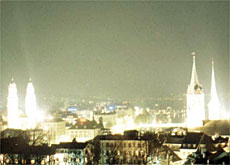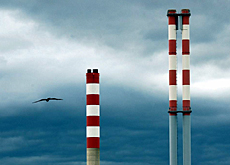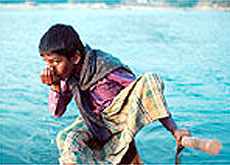Light pollution threatens night sky

Swiss campaigners have attended an international conference in Germany on tackling the problem of light pollution in the night sky.
The symposium attracted astronomers, ornithologists and even health experts.
Scientists estimate that a fifth of the world’s population can no longer see the Milky Way galaxy and several of the 12 constellations featured in horoscopes have become completely invisible in light-polluted areas.
Organisers from the International Dark Sky Association say their priority is effective outdoor lighting which points downwards.
“We don’t want to switch off the lights,” Philipp Heck, president of Dark Sky Switzerland, told swissinfo. “We just want people to direct light where it is needed without illuminating the whole sky.”
Milky Way
The oldest public observatory in Switzerland stands just off Zurich’s celebrated Bahnhofstrasse where it was built in 1907.
“This is probably the worst place in Zurich for light pollution,” said Heck. “For planets and the moon, it’s still perfectly suited but it has been years since I saw a galaxy here from the city centre.
“From a city like Zurich, you can only see the brightest stars and only the brightest constellations and there are not many of these.”
“If all the lights in Zurich were fully shielded, if there was no upward directed light, you could see the Milky Way on a moonless night from the centre of Zurich.”
Heck says in Switzerland there are only two regions left where light pollution is at a low level – in the Gotthard area of central Switzerland and canton Graubünden in the southeast.
Not surprisingly, the problem is worse around densely populated areas, particularly in industrialised countries.
Satellite images show that Europe, the eastern part of the United States, Japan and India are the main generators of light pollution.
Migrating birds
Astronomers started complaining about the glow from urban areas in the 1950s but now other groups are voicing concern.
Ornithologists say illuminated structures confuse birds and cause them to deviate from their migrating routes.
Bruno Bruderer of the Swiss Ornithological Institute has discovered that migrating birds will change direction, speed and altitude.
Such deviations during long migrations can mean the difference between life and death for weaker birds.
Meanwhile, a German study has estimated that 150 insects a night die around every street lamp.
Once attracted to the light, they circle around until exhaustion leaves them unable to reproduce or feed normally, or they fall prey to predators.
“There are probably some 50,000 street lights in Zurich, which means a million dead insects a night in the city alone,” said Heck “It affects not only the insect population but the whole food chain.”
Some researchers have even suggested a link between the increased incidence of breast cancer in the industrialised world and the way in which exposure to light at night can disrupt natural secretion cycles of the hormone melatonin.
Light show
“Most of the public street lights here are very well designed,” Heck told swissinfo on a recent tour of Zurich. “They are fully shielded and there is no direct upward light. But there are also many private globes which are very bad examples.”
“With globe lamps, most of the light goes directly into the sky. It’s a waste of energy and a waste of light. It is more efficient to shield it or apply a reflector so that the light which goes upwards is reflected on the ground where it is needed.
Illuminated church facades are another huge problem, adds Heck, pointing out the Grossmünster and other city churches bathed in light.
“If it’s done from below, it doesn’t even illuminate the building,” he said. “If we prevent or minimalise light pollution, we also reduce energy consumption.”
Dark Sky Switzerland dismisses security fears saying efficient outdoor illumination means reducing glare so that pedestrians are not blinded.
On track
The local authorities in Zurich have a lighting plan which aims to redesign the outdoor illumination of the city over a ten-year period, choosing designs that minimise light pollution.
Dark Sky Switzerland would like to see more action at the national level and has urged the Swiss environment agency to tackle light pollution as it does air and water pollution.
The group’s engineers help to make professional recommendations about light design.
When the Swiss Federal Railways announced plans to equip more than 600 regional stations with so-called Railbeams – eight metre high columns of light, illuminated from below – Dark Sky Switzerland swung into action.
After lengthy negotiations, the company agreed to compromise, redesigning its beams.
“The amount of light that is used for the redesigned Railbeams is less than the light wasted in the original version,” said Heck.
“There are no negative aspects in reducing light pollution. You save energy and you save light. It’s also an aesthetic improvement.”
“It’s much nicer if you see a well illuminated street but are not disturbed by the glare. It’s even nicer if you can walk through the city and see a starry sky.”
swissinfo, Vincent Landon
The International Dark Sky symposium took place in Stuttgart, Germany on September 12-13.
Campaigners called for better downward-pointing street lighting.
They said good lighting brings energy efficiency, security, health and ecological benefits.

In compliance with the JTI standards
More: SWI swissinfo.ch certified by the Journalism Trust Initiative


You can find an overview of ongoing debates with our journalists here. Please join us!
If you want to start a conversation about a topic raised in this article or want to report factual errors, email us at english@swissinfo.ch.